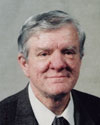Michael W. O'Neill, University of Houston Cullen Distinguished Professor of Civil Engineering, will receive the 2002 Distinguished Service Award from the Deep Foundations Institute at the organization's 27th annual conference Thursday, Oct. 10 at the Del Coronado Hotel in San Diego, Calif.
The award recognizes O'Neill for his exceptional contributions to the deep foundations industry, an exceptional accomplishment for a university scholar. Throughout the 22-year history of the award, the recipient has typically been an industry practitioner. O'Neill is only the fifth university professor to claim the prize.
O'Neill, who holds a Ph.D. from the University of Texas at Austin, has 40 years of experience in applied research and consulting in deep foundations, soil properties, engineering design and field testing of foundation systems. He has won numerous honors and awards, including being named the 1998 Karl Terzaghi Lecturer for the American Society of Civil Engineers.
In addition, O'Neill has published more than 200 papers and peer-reviewed reports on foundations and soil mechanics since 1964. He is the co-author of a reference book on foundations for vibrating machines and the current Federal Highway Administration manual on drilled shafts.
"Basically, what I've been trying to do during my career," says O'Neill, "is understand the behavior of deep foundations in just about every aspect: dynamic, static, the effect of installing the foundation on the soil properties, monitoring scour, how foundations interact with each other through the soil, group effects, how to enhance capacity, and electro-osmosis."
The hallmark of O'Neill's many achievements in the study of deep foundations stems back to a realization he had in graduate school.
"It dawned on me that the fundamental problem you had with deep foundations was determining the effect of constructing the foundation on the soil or the rock that you put it in," he says. "It's hard enough to try to characterize the soil--its stress-strain property, its strength, its compressibility--and it's even harder to figure out how the construction of the foundation effects those properties and what effect that has on the behavior of the foundation."
That realization catapulted O'Neill to a series of breakthroughs that still shape government regulations and industry practice across several areas, including deep water drilling, drilling on expansive soils, and strengthening bridge foundations in flood-prone areas.
O'Neill's current interests lie in rapid construction.
"The more quickly you can construct something or retrofit it, the better it is," O'Neill says. "It saves money, it's less lost time for traffic, and it's less bothersome to the surrounding community. The key to good rapid construction is reducing the coring, the amount of drilling in rock or soil. Solving this problem will help foundation construction in virtually every city in the country."
